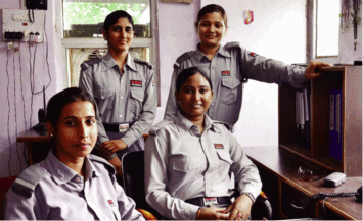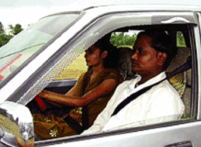India is no easy place to be a woman. Despite comprising a workforce majority in the teeming nation of 1.2 billion with equal rights under a 1949 constitution, India’s women are almost universally exploited while often denied access to health, education and other basic needs. Worse, the world’s second most populous nation looms among the most dangerous places for gender-based violence.

Rio Tinto has made empowerment of women at its Bunder diamond project in Madhyar Pradesh a top priority, including a women’s security detail.
Madhya Pradesh, one of India’s poorest regions and home to Rio Tinto’s Bunder Diamond Project, is emblematic: In 2011, the National Crime Bureau recorded 3,406 assaults against women—surely a conservative figure, and the highest rate nationwide. But while meeting local women pending development of India’s No. 1 diamond resource the year before, Rio officials noticed another grouping: dozens of raised hands at a community meeting—all hoping for driving skills.
The diversified Anglo-Australian giant is now beating the curve in empowering women in a deeply tribal, hardscrabble land booming India has long since forgotten. Through community development, moreover, Rio Tinto is bringing a Corporate Social Responsibility (CSR) win-win for women in a trajectory where half marry before 18, and 60% of whom give birth within a year amid one of the highest infant mortality rates worldwide.
The story surrounding Rio’s CSR footprint in the 15 villages of 15,000 inhabitants each surrounding its Bunder site dates to 2006, two years after the discovery of porous volcanic outcroppings revealed the deposit. Over the next two years, Rio initiated a baseline survey indicating highly “feudal and patriarchal traditions” leaving women with exceptionally poor literacy, health, nutrition and community decision-making ability.
The result: a pilot program in Sagoria Village, yielding further engagement to explain human rights concepts to local women while encouraging network building and social bonding. These ongoing focus groups, added Rio officials, expanded across communities in the region 500 km southeast of New Delhi with coordination by the Chhatarpur District’s Department of Women and Child Development.
India has one of the world’s highest illiteracy rates, and the women of Madhya Pradesh are well represented—55% can neither read nor write. Mindfully, and with the help of a local nongovernmental organization (NGO) Gramdyog Sansthan, Rio also supported a traveling HIV/AIDS awareness performance in the region; so far, 12,000 have attended.
Literacy is addressed among further instructional programs emphasizing nutrition, health, childcare and employment. Local women draped in ornate saris, or traditional headscarves, often seen cradling their children, are pleased with the results. “If we’re going somewhere and something’s written, we know where we’re going,” said one woman; like many, she wore a nose ring, one way Hindus honor Parvathi, the goddess of marriage.
In its isolation, Madhya Pradesh boasts some of India’s great, unspoiled historical legacies. These include opulent temples harkening to the architecture, art and lifestyles of Hindu and Jain dynastic grandeur—alongside unremitting poverty: With India’s fourth-lowest GDP, its sixth-largest state also faces widespread hunger, despite its aqrarian economy and nascent tourism focused on wildlife and history.

Rio Tinto has also instituted a unique driving course for local women, allowing some to work onsite.
Understanding this disconnect has proven key to developing gender-oriented projects, according to Rio Tinto community relations specialists. “In Bunder there was inevitably wariness,” recalled Community Relations Advisor Santosh Pathak, “especially from male family members—to women taking on this less-than-traditional role, not to mention them training and working alongside other men.”
This was on display after nearly a dozen women underwent a four-month 2012 driving course—featuring dual control vehicles and basic mechanical lessons—with strong community support. A core group between ages 18 and 35 has since joined the Bunder Project (mirroring a more troubled campaign to promote women taxi drivers in Indian cities.)
However, the process was not without serious risks, according to Lisa Dean, principal advisor in the Communities and Social Performance Team. “Women leading change can often be significantly challenged in relation to their own place in the community,” she said in a 2013 report by UN Global Compact Network Australia, part of a worldwide strategy promoting business sustainability.
Moreover, as women become “change agents . . . this can come at a tremendous individual cost—and we have to be prepared to give them the support they need in these situations,” Dean added.
The driving program, for instance, succeeds through talks balancing concerns and interests of family members, local Indian operational staff and a women’s NGO. “We overcame this by talking to these groups,” Santosh added. “It helped they could see we were a big, stable organization.”
In a similar vein, meanwhile, more than a dozen women from outside the area have joined the project’s security detail. Security managers located a police training academy in Punjab state, which recruited and trained the women for these roles.
The Bunder initiatives, enhanced by a Memorandum of Understanding (MoU) with children’s aid organization UNICEF from 2008, constitute what Rio terms a “virtuous circle” of inclusivity—and productivity. “It has raised both men’s and the women’s performance,” said Rio Tinto Group Advisor for Diversity and Inclusion Nadia Younes. “Men and women mining together makes for better mining—and case studies coming from our operations support this.”
Across global mining sector CSR programs, the systematic, data-driven nature behind most mining operations still often trumps social awareness needs, Dean acknowledged. “We are a subset within a large subculture of miners and engineers and people who think in a linear way and want a metric for these things,” she said. People are “prepared to accept complicated metallurgy—but it takes time to get internal acceptance that working with communities may be as complicated,” Dean added.
The very nature and dimensions of the Bunder project underscores this. Five years after a 2004 discovery of a cluster of volcanic rock, studies have revealed a 53.7-million-metric ton (mt) Kimberlite deposit containing an estimated 34.2 million carats in diamond content. A mine plan was accepted by government officials in Q3 and a fully modular $7 million sample processing plant has since been installed, while Rio is investing $500 million for asset development; Madhya Pradesh will become one of the world’s top-10 diamond producing regions.
It’s a massive undertaking, of course. But companies like Rio Tinto, the world’s second-largest mining company, are increasingly leveraging their abilities—accessing resources below ground while making a lasting difference above it.






